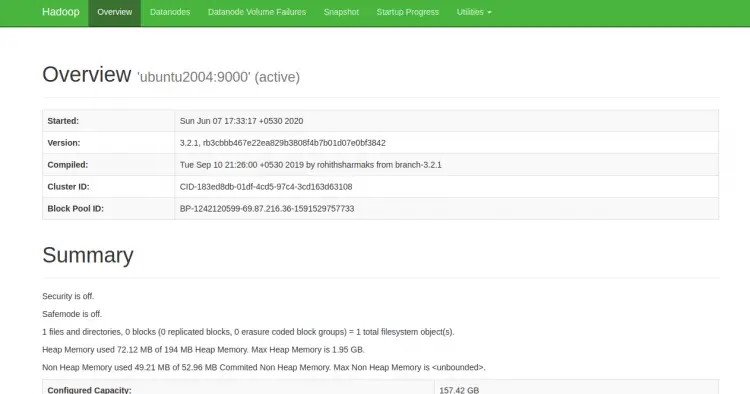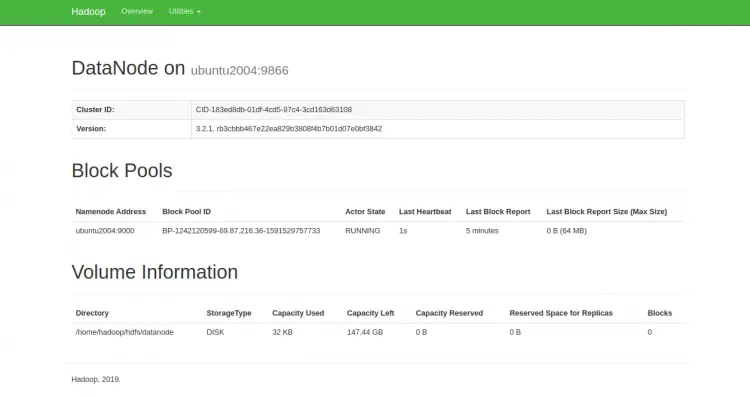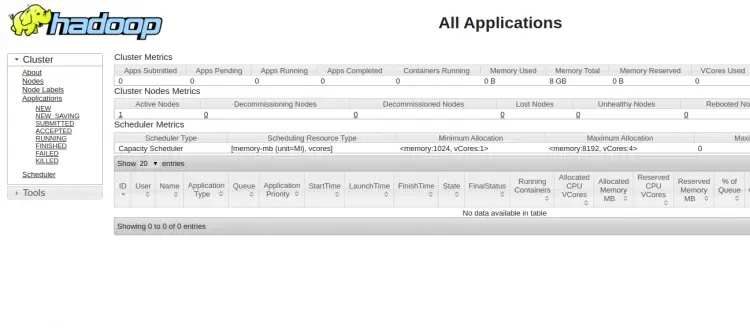
How to download the latest version of hadoop - apologise, but
How to Install and Configure Apache Hadoop on Ubuntu 20.04
Apache Hadoop is an open-source framework used to manage, store and process data for various big data applications running under clustered systems. It is written in Java with some native code in C and shell scripts. It uses a distributed file system (HDFS) and scale up from single servers to thousands of machines.
Apache Hadoop is based on the four main components:
- Hadoop Common : It is the collection of utilities and libraries needed by other Hadoop modules.
- HDFS : Also known as Hadoop Distributed File System distributed across multiple nodes.
- MapReduce : It is a framework used to write applications to process huge amounts of data.
- Hadoop YARN : Also known as Yet Another Resource Negotiator is the resource management layer of Hadoop.
In this tutorial, we will explain how to set up a single-node Hadoop cluster on Ubuntu 20.04.
Prerequisites
- A server running Ubuntu 20.04 with 4 GB RAM.
- A root password is configured on your server.
Update the System Packages
Before starting, it is recommended to update your system packages to the latest version. You can do it with the following command:
Once your system is updated, restart it to implement the changes.
Install Java
Apache Hadoop is a Java-based application. So you will need to install Java in your system. You can install it with the following command:
Once installed, you can verify the installed version of Java with the following command:
You should get the following output:
openjdk version "11.0.7" 2020-04-14 OpenJDK Runtime Environment (build 11.0.7+10-post-Ubuntu-3ubuntu1) OpenJDK 64-Bit Server VM (build 11.0.7+10-post-Ubuntu-3ubuntu1, mixed mode, sharing)Create Hadoop User and Setup Passwordless SSH
First, create a new user named hadoop with the following command:
Next, add the hadoop user to the sudo group
usermod -aG sudo hadoop
Next, login with hadoop user and generate an SSH key pair with the following command:
You should get the following output:
Generating public/private rsa key pair. Enter file in which to save the key (/home/hadoop/.ssh/id_rsa): Created directory '/home/hadoop/.ssh'. Enter passphrase (empty for no passphrase): Enter same passphrase again: Your identification has been saved in /home/hadoop/.ssh/id_rsa Your public key has been saved in /home/hadoop/.ssh/id_rsa.pub The key fingerprint is: SHA256:HG2K6x1aCGuJMqRKJb+GKIDRdKCd8LXnGsB7WSxApno [email protected] The key's randomart image is: +---[RSA 3072]----+ |..=.. | | O.+.o . | |oo*.o + . o | |o .o * o + | |o+E.= o S | |=.+o * o | |*.o.= o o | |=+ o.. + . | |o .. o . | +----[SHA256]-----+Next, add this key to the Authorized ssh keys and give proper permission:
Next, verify the passwordless SSH with the following command:
Once you are login without password, you can proceed to the next step.
Install Hadoop
First, log in with hadoop user and download the latest version of Hadoop with the following command:
Once the download is completed, extract the downloaded file with the following command:
Next, move the extracted directory to the /usr/local/:
Next, create a directory to store log with the following command:
Next, change the ownership of the hadoop directory to hadoop:
Next, you will need to configure the Hadoop environment variables. You can do it by editing ~/.bashrc file:
Add the following lines:
export HADOOP_HOME=/usr/local/hadoop export HADOOP_INSTALL=$HADOOP_HOME export HADOOP_MAPRED_HOME=$HADOOP_HOME export HADOOP_COMMON_HOME=$HADOOP_HOME export HADOOP_HDFS_HOME=$HADOOP_HOME export YARN_HOME=$HADOOP_HOME export HADOOP_COMMON_LIB_NATIVE_DIR=$HADOOP_HOME/lib/native export PATH=$PATH:$HADOOP_HOME/sbin:$HADOOP_HOME/bin export HADOOP_OPTS="-Djava.library.path=$HADOOP_HOME/lib/native"Save and close the file when you are finished. Then, activate the environment variables with the following command:
Configure Hadoop
In this section, we will learn how to setup Hadoop on a single node.
Configure Java Environment Variables
Next, you will need to define Java environment variables in hadoop-env.sh to configure YARN, HDFS, MapReduce, and Hadoop-related project settings.
First, locate the correct Java path using the following command:
You should see the following output:
/usr/bin/javacNext, find the OpenJDK directory with the following command:
You should see the following output:
/usr/lib/jvm/java-11-openjdk-amd64/bin/javacNext, edit the hadoop-env.sh file and define the Java path:
Add the following lines:
export JAVA_HOME=/usr/lib/jvm/java-11-openjdk-amd64 export HADOOP_CLASSPATH+=" $HADOOP_HOME/lib/*.jar"Next, you will also need to download the Javax activation file. You can download it with the following command:
You can now verify the Hadoop version using the following command:
You should get the following output:
Hadoop 3.2.1 Source code repository https://gitbox.apache.org/repos/asf/hadoop.git -r b3cbbb467e22ea829b3808f4b7b01d07e0bf3842 Compiled by rohithsharmaks on 2019-09-10T15:56Z Compiled with protoc 2.5.0 From source with checksum 776eaf9eee9c0ffc370bcbc1888737 This command was run using /usr/local/hadoop/share/hadoop/common/hadoop-common-3.2.1.jarConfigure core-site.xml File
Next, you will need to specify the URL for your NameNode. You can do it by editing core-site.xml file:
Add the following lines:
<configuration> <property> <name>fs.default.name</name> <value>hdfs://0.0.0.0:9000</value> <description>The default file system URI</description> </property> </configuration>Save and close the file when you are finished:
Configure hdfs-site.xml File
Next, you will need to define the location for storing node metadata, fsimage file, and edit log file. You can do it by editing hdfs-site.xml file. First, create a directory for storing node metadata:
Next, edit the hdfs-site.xml file and define the location of the directory:
Add the following lines:
<configuration> <property> <name>dfs.replication</name> <value>1</value> </property> <property> <name>dfs.name.dir</name> <value>file:///home/hadoop/hdfs/namenode</value> </property> <property> <name>dfs.data.dir</name> <value>file:///home/hadoop/hdfs/datanode</value> </property> </configuration>Save and close the file.
Configure mapred-site.xml File
Next, you will need to define MapReduce values. You can define it by editing mapred-site.xml file:
Add the following lines:
<configuration> <property> <name>mapreduce.framework.name</name> <value>yarn</value> </property> </configuration>Save and close the file.
Configure yarn-site.xml File
Next, you will need to edit the yarn-site.xml file and define YARN related settings:
Add the following lines:
<configuration> <property> <name>yarn.nodemanager.aux-services</name> <value>mapreduce_shuffle</value> </property> </configuration>Save and close the file when you are finished.
Format HDFS NameNode
Next, you will need to validate the Hadoop configuration and format the HDFS NameNode.
First, log in with Hadoop user and format the HDFS NameNode with the following command:
You should get the following output:
2020-06-07 11:35:57,691 INFO util.GSet: VM type = 64-bit 2020-06-07 11:35:57,692 INFO util.GSet: 0.25% max memory 1.9 GB = 5.0 MB 2020-06-07 11:35:57,692 INFO util.GSet: capacity = 2^19 = 524288 entries 2020-06-07 11:35:57,706 INFO metrics.TopMetrics: NNTop conf: dfs.namenode.top.window.num.buckets = 10 2020-06-07 11:35:57,706 INFO metrics.TopMetrics: NNTop conf: dfs.namenode.top.num.users = 10 2020-06-07 11:35:57,706 INFO metrics.TopMetrics: NNTop conf: dfs.namenode.top.windows.minutes = 1,5,25 2020-06-07 11:35:57,710 INFO namenode.FSNamesystem: Retry cache on namenode is enabled 2020-06-07 11:35:57,710 INFO namenode.FSNamesystem: Retry cache will use 0.03 of total heap and retry cache entry expiry time is 600000 millis 2020-06-07 11:35:57,712 INFO util.GSet: Computing capacity for map NameNodeRetryCache 2020-06-07 11:35:57,712 INFO util.GSet: VM type = 64-bit 2020-06-07 11:35:57,712 INFO util.GSet: 0.029999999329447746% max memory 1.9 GB = 611.9 KB 2020-06-07 11:35:57,712 INFO util.GSet: capacity = 2^16 = 65536 entries 2020-06-07 11:35:57,743 INFO namenode.FSImage: Allocated new BlockPoolId: BP-1242120599-69.87.216.36-1591529757733 2020-06-07 11:35:57,763 INFO common.Storage: Storage directory /home/hadoop/hdfs/namenode has been successfully formatted. 2020-06-07 11:35:57,817 INFO namenode.FSImageFormatProtobuf: Saving image file /home/hadoop/hdfs/namenode/current/fsimage.ckpt_0000000000000000000 using no compression 2020-06-07 11:35:57,972 INFO namenode.FSImageFormatProtobuf: Image file /home/hadoop/hdfs/namenode/current/fsimage.ckpt_0000000000000000000 of size 398 bytes saved in 0 seconds . 2020-06-07 11:35:57,987 INFO namenode.NNStorageRetentionManager: Going to retain 1 images with txid >= 0 2020-06-07 11:35:58,000 INFO namenode.FSImage: FSImageSaver clean checkpoint: txid=0 when meet shutdown. 2020-06-07 11:35:58,003 INFO namenode.NameNode: SHUTDOWN_MSG: /************************************************************ SHUTDOWN_MSG: Shutting down NameNode at ubuntu2004/69.87.216.36 ************************************************************/Start the Hadoop Cluster
First, start the NameNode and DataNode with the following command:
You should get the following output:
Starting namenodes on [0.0.0.0] Starting datanodes Starting secondary namenodes [ubuntu2004]Next, start the YARN resource and nodemanagers by running the following command:
You should get the following output:
Starting resourcemanager Starting nodemanagersYou can now verify them with the following command:
You should get the following output:
5047 NameNode 5850 Jps 5326 SecondaryNameNode 5151 DataNodeAccess Hadoop Web Interface
You can now access the Hadoop NameNode using the URL http://your-server-ip:9870. You should see the following screen:

You can also access the individual DataNodes using the URL http://your-server-ip:9864. You should see the following screen:

To access the YARN Resource Manager, use the URL http://your-server-ip:8088. You should see the following screen:

Conclusion
Congratulations! you have successfully installed Hadoop on a single node. You can now start exploring basic HDFS commands and design a fully distributed Hadoop cluster. Feel free to ask me if you have any questions.


-